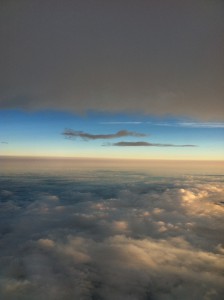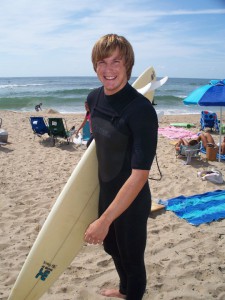This post was provided by Nick Heath, a student from Florida State University on the Studies of Emissions and Atmospheric Composition, Clouds and Climate Coupling by Regional Surveys (SEAC4RS) airborne science mission.
Today’s blog comes from above the clouds, high in the atmosphere in which we live…the one SEAC4RS hopes to better understand. I’m flying home for a week. Speaking of flying, these first 20 days also have flown by, and I can’t wait to get back to Houston for 30 more. As a graduate student who spends most of his time reading peer-reviewed articles and writing computer code, SEAC4RS has provided me a humbling and rewarding experience thus far. I gave my first weather briefing, led a morning pre-flight brief, and contributed as much as possible whenever I could. SEAC4RS also has taught me the importance of urgency. Us scientists (and humans for that matter) always like to be prepared. We like to plan ahead. Unfortunately, with weather forecasting, there is no planning ahead (I know that sounds contradictory!). Things are always changing; so to provide the best forecast, you have to wait for the latest data. This means that you are forced to procrastinate. Then, like the people waiting for their boarding zone to be called, there is a huge “rush to the gate.” But, I’ve found that this isn’t always a bad thing. Sometimes urgency brings out the best in everyone. You become much more efficient, you work as a unit, and you learn what works and what doesn’t. Think of a wild animal out on a hunt: they wait and wait until an opportunity presents itself…they then exhaust an extreme amount of energy in a very short period…followed by relaxation and the reward of having their next meal. Our process is not all that different…we “pounce” on the latest data, exhaust a lot of energy into our briefing, and then get to relax and let the feeling of “a job well done” soak in…very primal of us! In short, I have learned that procrastination is not always a bad thing, and may in fact be beneficial in some cases…(but not for school work, of course!).
As for the status of SEAC4RS, things are going great! We flew into some smoke a few days ago, and then spent the all of Friday in the southeast U.S. examining chemistry, radiation, and convective clouds. Next on the agenda is what we call a suitcase flight: the DC-8 will travel into the northwest U.S., stay the night, and fly back the next day. This allows a lot more time to study the region. While in the northwest, we will be studying smoke from wildfires occurring in both California and Idaho. These fires have been a hot topic in the news lately, and SEAC4RS aims to understand their impacts on the large scale.
Lastly, as I am flying, the plane just encountered some “rough air” at 36,000 ft. Next time you are flying, and experience turbulence, and get that strange feeling in your stomach, think of SEAC4RS. These scientists are chasing rough air, flying around storms, putting their life in danger, for the hopes of better understanding the processes that affect our world. Not your typical scientists, that’s for sure.







